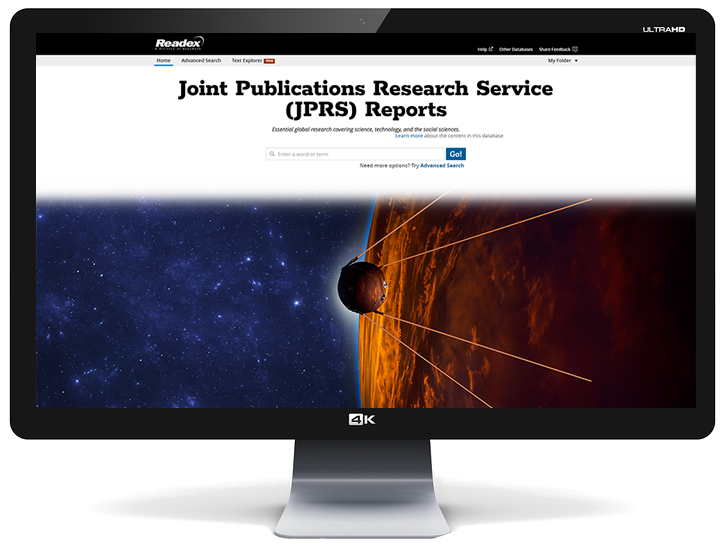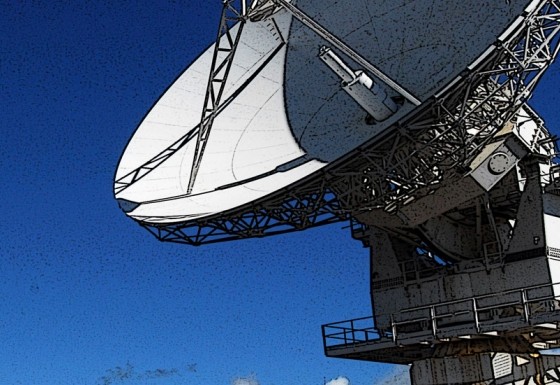
Joint Publications Research Service (JPRS)
Reports, 1957-1995
- Ideal for researching socioeconomic, political, environmental, scientific, technical and military issues and events
- Translated materials enable researchers to explore a vast repository of foreign material
- Contains monographs, reports, serials, journal and newspaper articles, and reference sources
From the height of the Cold War to the dawn of the Internet and the dissolution of the Soviet Union, JPRS reports document the changes on the ground during that tumultuous time. JPRS—acting as a unit within the Central Intelligence Agency—was established in March 1957 as part of the United States Department of Commerce’s Office of Technical Services, about six months before the Soviet Union launched Sputnik 1. JPRS staffers prepared translations for use by U.S. government officials, various agencies, and the research and industrial communities.
During the Cold War, the reports were primarily translations rather than analysis or commentary, balancing political coverage with scientific and technical topics. Over time, however, that scope expanded to cover environmental concerns, world health issues, nuclear proliferation, and more.
This unique collection—fully searchable for the first time—features English translations of foreign-language monographs, reports, serials, journal and newspaper articles from regions throughout the world. With an emphasis on communist and developing countries, this digital edition of Joint Publications Research Service (JPRS) Reports, 1957-1995, contains a wealth of hard-to-find social science, scientific, and technical materials translated from many languages; in fact, few libraries or institutions outside of the Central Intelligence Agency and the Library of Congress hold a comprehensive microform edition, especially for the first two decades following the founding of JPRS.
Translated materials form a one-of-a-kind resource
Featuring millions of pages from more than 130,000 reports, the Readex digital edition of Joint Publications Research Service (JPRS) Reports, 1957-1995 enables researchers to explore a vast body of foreign material. These reports, some of which are quite rare, are ideal for researching military, socioeconomic, political, environmental, scientific and technical issues and events. The authoritative Readex digital edition features an intuitive interface that includes digital full-text searching, metadata search assistance, and an individual bibliographic record for each JPRS Report.
Essential for a wide range of researchers
The breadth and depth of this collection makes it an exceptional tool for studying geo-politics, global threat assessments, public policy, foreign intelligence, national security, the Cold War and much more. JPRS Reports, 1957-1995, is also an essential complement to the closely related Foreign Broadcast Information Service Daily Reports, 1941-1996.
Essential Global Media, 1939-2001
“…two new products from Readex, via the meticulous translation work of the Joint Publications Research Service and the Foreign Broadcast Information Service, open our eyes to how Middle Eastern editors, journalists, and broadcasters viewed the events around them during the second half of the 20th century….
“Students of Middle East and North Africa history, politics, economics, and culture get an unfiltered view of the events of this intensely active region during the second half of the 20th century thanks to Middle East and North Africa: Global Perspectives, 1958–1994, and the companion product Part 1: Middle East, Africa, Near East and South Asia—one of eight distinct area subsets of the complete collection of Foreign Broadcast Information Service (FBIS) Daily Reports, 1974–1996….JPRS and FBIS translations are regarded as accurate and scrupulously unbiased.
“….both products stand apart from similar offerings, approaching unique and fascinating content on issues and events in the Middle East with perspectives that are not represented in other databases.”
— Gail Golderman and Bruce Connolly, “Reference eReviews,” Library Journal (July 2017)
“The definition between government document and nongovernment document blurs, particularly as the intelligence tentacles of the United States government seek every shred of information, news, detail—and bring it home for contemplation, digestion and eventual redistribution....
“Prime examples of the ‘documentization’ of information are the United States Joint Publications Research Service (JPRS) and its equally acquisitive partner, the Foreign Broadcast Information Service (FBIS)....Of interest here are the transforming effect these services have on the information they amass and the research and societal value that results.
“The significance of information collected by JPRS and FBIS is enormous. Of greatest importance is the diversity of viewpoints suddenly made accessible by subject and in English. To be able to understand these resources in relation to their special provenances is especially critical in appraising their informational value.
“FBIS, for example, literally provides an ear to the rest of the world through the collection and translation of radio news and editorial broadcasts....
“JPRS provides equally important access to foreign newspapers, books, technical reports, and other printed materials. The significance may not end with the simple fact of convenient availability, but rather with the status accorded this information as newly created government documentation. That much of this material contradicts claims of the United States government (the very authority which, by virtue of its collection of these materials, gives them, in certain circumstances, greatly augmented validity) is an appropriate irony to be savored....
“Information acquires meaning when it can be used. The format of the material matters little; content should be the critical factor. Librarians have this opportunity to contribute to and participate in the evolution of meaning.”
— Glenda J. Pearson, “Government Publications on Microform: Integrated Reference Services,” in Microform Review (Dec. 1988)
"A long time ago the University of Denver was a depository for several Joint Publications Research Service (JPRS) series, a fact long-since forgotten now that all our documents are in a safe-and-secure remote storage facility. Brief MARC records cannot possibly capture the wealth of translated information found in this information-rich complement to Foreign Broadcast Information Service (FBIS) documents. But the Readex digital edition of JPRS Reports will unearth the rich scientific and cultural gems from the USSR and Eastern bloc countries, China, Vietnam, and other areas of concern from the late 1950s through the early 1990s. Not only will scientific information be found in these documents ('Problems of Space Biology'), but also matters of cultural and sociological significance ('Summary of the Polish Provincial Press' and 'Soviet Transportation' are among the series-within-series publications). JPRS Reports, 1957-1995, should be considered a hidden source for selected statistics and yet another place for genealogists to check. Our internationalists will greatly benefit from this historic archive."
—Christopher C. Brown, Professor, Reference Technology Integration Librarian and Government Documents Librarian, Penrose Library, University of Denver
What was JPRS and what did it publish?
JPRS was a translation and publishing service created in the U.S. Commerce Department’s Office of Technical Services in March 1957 to provide government agencies with translations of unclassified foreign source documents, including:
- scientific and technical publications
- periodical and newspaper articles
- scholarly journals
- trade and commercial statistics reports
- defense-related and other special reports.
The documents were selected by area and subject specialists while translations were prepared by linguists and researchers. Today, JPRS reports are considered an important source of primary and secondary material from around the world. Subjects covered in the JPRS Reports include economics, international relations, national politics, military affairs, and science and technology.
Are JPRS reports still produced today?
Some JPRS operations were integrated into the Foreign Broadcasts Information Service (FBIS) publishing program until mid-1996 when the distribution of the FBIS Daily Reports in print and microform ended. The Open Source Center of the CIA then became responsible for electronic distribution of FBIS Reports, including types of material previously published separately by JPRS. Since 1996, the reports have been available electronically through “World News Connection.”
Are JPRS Reports, 1957-1995, similar to those found in the FBIS Daily Reports, 1941-1996?
While FBIS Daily Reports were largely political, focusing on local, regional, national and international events, JPRS Reports included a broader range of issues, some scientific (and political) such as nuclear proliferation, and others covering social issues, cultural matters, important political background, and international concerns like drug trafficking and epidemiological issues. JPRS Reports tend to be more extensive and in-depth than FBIS Daily Reports.
Do JPRS Reports complement or supplement FBIS Daily Reports?
Both. From its inception in 1957, JPRS translated primarily journals and collections of articles from journals, some monographs, some abstracts, and materials from other genres not included in the FBIS Daily Reports.
FBIS Daily Reports initially contained only broadcast material [i.e. short wave, radio, and then television]. Content was later expanded to include some newspapers [e.g. The Jerusalem Times], journals [e.g. Der Spiegel] and other printed materials. Beginning in the early 1980s the JPRS Reports begin to resemble more and more the FBIS Daily Reports until in the mid 1990s when the two series of reports, except for their cover pages and running heads, became almost indistinguishable. JPRS content, especially in some JPRS classes, became more like the material covered in FBIS than had been the case with the first two decades of JPRS translations.
How do the materials in JPRS break down by original language, content and content types?
Precise breakdowns will become known only upon completion of our digitization effort. However, we now estimate that original languages, in order by prominence, will probably be Russian, Chinese, the various languages of the Soviet allied or satellite states [e.g. Poland, Romania, Hungary, Czechoslovakia], and then Vietnamese, and so on. Almost certainly, JPRS content will include translations from fewer original languages than FBIS Reports. We also estimate that content will be close to evenly divided between cultural/political/social materials on the one hand and scientific/technical materials on the other hand. Distribution by subject matter will become fully known only when all the material has been digitized.
If JPRS focused its early reporting on defense and military matters, especially from Communist China and Soviet Union, how much other content is there of general interest?
Nearly half of the estimated early content will involve other than defense and military matters. It should be noted that even technical data can have interest beyond its primary information value, e.g. cost figures on some development breakthrough could reveal insight about economic investment and national strategy beyond the technical details.
In what ways might the research aims and activities of JPRS and FBIS users be similar?
There may be broad historical-cultural overlap of JPRS and FBIS content, for example:
a) The detailed Soviet atlas of Cuba in JPRS might be of real interest to historians and political scientists researching the Cuban missile crisis and the Bay of Pigs fiasco in FBIS;
b) The brief JPRS biographies of leading members of the political ruling classes in Romania and Hungary and other countries might be of high value to FBIS researchers;
c) The classes of materials on social and economic statistics in JPRS might find a ready audience among FBIS researchers studying the background of the events reported in the government controlled press in those countries.
What academic departments and disciplines should be most interested in JPRS?
Political Science, International Relations, Russian History, Chinese History, Vietnamese History, Communist Studies, Third-World Studies, science and technology, and general Cultural Studies
How large will the JPRS collection be in terms of reports, titles and pages?
The number of reports and titles will be the same because each Report has its own Report Title. Currently, upon completion, JPRS collection is estimated to consist of about 130,000 reports/titles and approximately four million pages. Any single JPRS Report, however, may consist of a single monograph title or a composite of many articles from the same or different journals.
How and when will JPRS Reports be made available?
JPRS reports will be released in reverse chronology, beginning with 1995 and ending with 1957, a schedule begun in late fall 2011 with completion planned for late 2015.
Do materials in JPRS duplicate any materials in FBIS?
There is a very, very small amount of overlap of JPRS Reports with the over seven million FBIS-translated or transcribed articles. For example, FBIS broadcasts may have been based on journal articles, read in full or in part on the air, which may also have been translated, for different reasons, by JPRS. The possible presence of partial duplication is an example of how FBIS and JPRS could complement one another.
Will researchers be able to search and browse both FBIS Daily Reports and JPRS Reports in a single interface using shared metadata and returning integrated results?
Yes.
Although JPRS will not be purchasable by region, will it be searchable by region?
While JPRS Reports are not organized by region, some classes of JPRS Reports do have regional or country focus, e.g. Soviet Union, Pakistan, China, etc. To that extent, limiting a search by region or country should be possible by selecting series classes.
What does a JPRS report look like?
It depends on the year of publication and the class of material. In the more recent years, say 1988-1995, a JPRS Report typographically and structurally looks very much like a FBIS Daily Report from the same period. Before the late 1970s JPRS Reports were mimeographed like the FBIS Reports had been although they bear little but superficial organizational similarity to them. Furthermore, the monographs, indexes, abstracts, purely scientific works, etc. in JPRS have no counterpart whatsoever in FBIS. That is to say there is far more variety of format and appearance in JPRS Reports than there is in FBIS Daily Reports, Serial Set House and Senate Legislative Reports, Congressional Hearings, etc.
Will MARC records for JPRS Reports be offered?
Yes, MARC records for each JPRS Report will be available as an option. MARC records at the article level will not be offered.
What metadata will be captured?
A) At the Report level, the individual numbered Reports, as follows:
- Report title (sometimes specific, like a unique monograph title, sometimes a JPRS serial-like title, and sometimes actual journal titles in the JPRS title subtitle, and some other variations)
- Report date
- Report JPRS number
- Report SuDoc number
- Report type
- Journal title[s] if present on Report cover page
- Report collation
- Report subjects
B) At the Article level for those Reports consisting of individual articles either from the same Journal or from a selection of Journals or other sources, as follows:
- Article title
- Article author or authors
- Article date or broadcast date
- Article type
- Article source
- Article original language
- Article maps, illustrations, photographs
There are a several indexes and guides to JPRS but there is apparently no single index that can be used for gaining access to JPRS reports. Will the Readex edition link to any of these indexes and guides, and their numbering schemes (for example, GPO Monthly Catalog numbers)?
No. The Readex digital version of the JPRS Reports will, by virtue of being searchable online, provide far better access to the JPRS Reports than any of the earlier paper or microform access tools.
What microform collections of JPRS Reports exist?
Microform collections of JPRS Reports—none of which is complete—were created by Readex, Research and Microform Publications (an Annapolis, Maryland operation), Bell and Howell, UMI, and since 1978 by GPO.
Who supplied paper copies of those JPRS Reports made publicly available?
Three entities: Library of Congress Photoduplication Service, the National Technical Information Service (established on Sept. 2, 1970, but with predecessors dating back to the Truman Administration), and the Documents Expediting Project of the Library of Congress.
Please explain the numbering system used for JPRS Reports.
Many different and sometimes overlapping, not to say confusing, numbering systems have been used for or applied to the JPRS Reports. These numbers appear on the title page; unlike most Congressional Reports, JPRS Reports do have actual title pages.
JPRS Numbers:
From early 1957 to 1960, JPRS numbering systems were in five different internal, i.e. title page, sequences with corresponding SuDoc classification numbers, i.e. NOT on the title page of the Reports, as follows:
JPRS (NY): Y.3.J66.8 /nos. nos. = 1-2250
JPRS (DC): Y.3.J66.9 /nos. nos. = 1-1200
JPRS (DC) L: Y.3.J66.10 /nos. nos. = 1-2050
JPRS (NY) L: Y.3.J66.11 /nos. nos. = 1-1250
JPRS R: Y.3.J66.12 /nos. nos. = 1-746
Early in 1960 [according to Mary Elizabeth Poole’s account] the five series were consolidated into a single JPRS sequential numbering system, for example: JPRS 46237.
At the beginning of each series of JPRS Reports in January 1984, one finds the following notification of a change in numbering:
“Effective with this issue JPRS is implementing a new numbering system for its Reports in which the dual numbering system currently in use will be replaced with a simple 15-character alpha-numeric code. Within this code, each JPRS Report will have a unique trigraph code. For example, the alphanumeric code for the first JPRS Japan Report issued in 1984 will be: JPRS-JAR-84-001.”
Monthly Catalog Numbers
The Monthly Catalog numbers are found in the Monthly Catalog of U.S. Government Publications. The number consists of a year designation followed by a sequential number for each item throughout the year. The Monthly Catalog number does not appear on any publication because the catalog post-dates the publications it lists each month.
For example: 1959-7920 is a Monthly Catalog number for JPRS publication 1620. Since there is no correspondence between Monthly Catalog numbers and JPRS numbers, Readex published for the 1958-1962 JPRS Reports, which he had numbered using the Monthly Catalog number for each Report, a Conversion Index of Monthly Catalog number to JPRS number. The Readex index covers October 1958, the date from which JPRS Reports began to be covered by the Monthly Catalog, until December 1963. Note that not all JPRS Reports are listed in the Monthly Catalog. Reports designated “For official Use Only” are not listed. Sometimes JPRS Reports are grouped together without individual listings, and gradually the inclusion of JPRS Reports becomes infrequent, eventually disappearing all together.
Superintendent of Documents (SuDoc) Numbers
The Superintendent of Documents classification numbers system represents “the grouping of subordinate units with the parent organization so that each full notation reveals the responsible issuing agency for the type of publication being classified. This type of system is called a provenance system—it organizes publications based upon issuing agency.” From JPRS numbers 68,727 to 73,854 the assigned SuDoc stem was Y3.J66: 13/ as organized by the Library of Congress. The SuDoc class for JPRS goes back much further. From JPRS numbers 73832 to the end the assigned SuDoc stem was PrEx 7.
Please provide a list of significant documents that illustrate the range and also the eclectic nature of the JPRS Reports.
Here is a sampling of JPRS Report Titles:
Report No. 20: Political theory and ideology in Communist China. Aug. 2, 1957. JPRS 863-D: Soviet developments in information processing and machine translation/Urgent tasks of scientific research and educational work in the field of logic. Voyshvillo, Ye. K. et al. Aug. 7, 1959
JPRS 2821: Translations on Communist China's commune economy. June 15, 1960. 22 p.
JPRS 3768: César Godoy Urrutia. Politics and contradictions in the plans of UNESCO (Chile) 1960.
JPRS 20904: Chinese-English dictionary of modern Communist usage. 1963. 831 p.
JPRS 45331: K.I. Shchelkin. Soviet atomic science and techniques. [Sovetskaia atomnaia nauka i technika] 1967. 126 p.
JPRS 46237: About the achievement of strategic surprise in the Summer-Fall Campaign of 1944 [in Russian], Voyenna-Istoricheskii zhurnal, No. 6, 1968, Shimanskii, Col. A., USSR, August 20, 1968. Translations No. 467.
JPRS 53167 [LC record] Main Title: National atlas of Cuba. Published/Created: [Arlington, Va.] United States Dept. of Commerce, Joint Publications Research Service, [may be ordered from the National Technical Information Service, Springfield, Va.] 1971. Description: c, 309 p. 27 cm. Notes: Cover title. Translation of the letterpress in Natsionalnyi atlas Kuby; without maps. Subjects: Cuba. Series: Translations on Latin America no. 525 JPRS 53167 JPRS (Series); 53167. Translations on Latin America, no. 525. LC Classification: G1605 .N3 1970.
Y3.J66:13/73854: Translations on East Europe: Political, Sociological, Military Affairs. [After JPRS 73854 this subseries becomes EAST EUROPE REPORT: Political, Sociological and Military Affairs PrEx7.13:73840-78719; PrEx7.17/2:1909- ].
JPRS-EEI-84-018: East Europe Report. ECONOMIC AND INDUSTRIAL AFFAIRS. Feb. 9, 1984. 103 p.
JPRS-UMA-85-002: USSR Report. MILITARY AFFAIRS. Jan. 10, 1985. 44 p.
JPRS-EPS-85-037: East Europe Report. POLITICAL, SOCIOLOGICAL AND MILITARY AFFAIRS. Mar. 21, 1985. 201 p. JPRS-TND-93-014: Nuclear proliferation. [on Pakistan’s uranium enrichment facility at Kahuta] May 18, 1993. 34 p.
Please provide examples of how scientists and scholars actually cite, and therefore use, JPRS translations in their published research.
Here is a sampling of citations of translated documents found in JPRS Reports:
JPRS 80968, June 3, 1982: JPRS Report title: The Anti-Resistance War for National Salvation, 1954-75 by the [Vietnam] War Experiences Recapitulation Committee of the High-level Military Institute. Cited in the article: “The War Politburo: North Vietnam’s diplomatic and political road to the Têt Offensive” by Lien-Hang T. Nguyen. Published in the Journal of Vietnamese Studies, Vol. 1, No. 1-2, 2006. Also cited in The Fog of War: Lessons from the Life of Robert S. McNamara by Bright and Lang (2005).
JPRS-UMA-91-014, June 5, 1991: JPRS Report title: Central Eurasia: Military Affairs. JPRS article title: “Former Soviet advisor describes experiences in Iraq: I taught Saddam’s aces to fly” by Lt. Col. Sergey Ivanovich Belzyudnyy. Cited in the article “Armies of snow and armies of land: The impact of Soviet military doctrine on Arab militaries” by Michael Eisenstadt and Kenneth M. Pollack. Published in the Middle East Journal, Vol. 55, No. 4, Autumn 2001.
JPRS TND-85-030, December 4, 1985: JPRS Report title: Nuclear Development and Proliferation JPRS article title: "Teamwork in nuclear power generation” by S. Stanev (1984). Cited in the article “Nuclear power in Cuba after Chernobyl” by Jorge F. Perez-Lopez. Published in the Journal of Interamerican Studies and World Affairs, Vol. 29, No. 2 (Summer 1987).
JPRS 24061, 1963: JPRS Report title: Abstracts of Zooparasitology (Referativnyi Zhurnal: Biologiya) No. 7. Cited in the article “Society Business” by Donald Fairbairn and Everett L. Schiller. Published in the Journal of Parasitology, Vol. 51, No. 3 (June 1965).
JPRS 19209, May 16, 1963: JPRS Report title: Chung-kuo Ti-chih Hsueh [The geology of China] by Ta Ch'ang, 1959. Cited in the article “Continental Drift, III: Late Paleozoic glacial centers, and Devonian-Eocene coal distribution” by A. A. Meyerhoff and Curt Teichert. Published in the Journal of Geology, Vol. 79, No. 3 (May 1971).
JPRS 4838, Aug. 3, 1961: JPRS Report title: Radio and Television in the USSRby S. V. Kaftanov et al. Cited in the article “Alfred Schnittke's Nagasaki: Soviet Nuclear Culture, Radio Moscow, and the Global Cold War” by Peter J. Schmelz. Published in the Journal of the American Musicological Society, Vol. 62, No. 2 (Summer 2009). [N.B. the JPRS No. in the article was mistakenly cited as 4742.]
JPRS-UAC-91-003, June 28, 1991: JPRS Report title: Central Eurasian Report: Aviation and Cosmonautics. JPRS article title: “Blank spots of history: In the skies over North Korea” by Georgi Lobov. Cited in the article “China and the air war in Korea” by Ziaoming Xhang. Published in the Journal of Military History, Vol. 62, No. 2, April 1998.
JPRS 58203, Feb. 12, 1973: JPRS Report title: Changes in permeability of histo-hematic barriers under the effect of microwaves by L.V. Polyashchuk. Cited in the article “Radiofrequency-Radiation Exposure Does Not Induce Detectable Leakage of Albumin across the Blood-Brain Barrier” by L. Po. Published in the journal Radiation Research, Vol. 171, No. 5, May 2009.
JPRS 21975, Nov. 21, 1963: JPRS Report title: Studies of radiation in sanitation - USSR. JPRS article title: “The use of the combined effect of gamma-radiation and chlorine for sterilization of water” by G. I. Sidorenko, M. A. Pinigin, and V. T. Savenkova. Cited in the article “The practicality of using atomic radiation for wastewater treatment” by D. S. Ballantine, L. A. Miller, D. F. Bishop, F. A. Rohrman. Published in the Journal of the Water Pollution Control Federation, Vol. 41, No. 3, Part I (Mar., 1969). [N.B. the JPRS No. in the article was mistakenly cited as 21915.]
Stay in Touch
Receive product news, special offers and invitations, or the acclaimed Readex Report
Sign UpBy clicking "Sign Up", you acknowledge that you have read and understand our Privacy Policy and Terms of Use.





